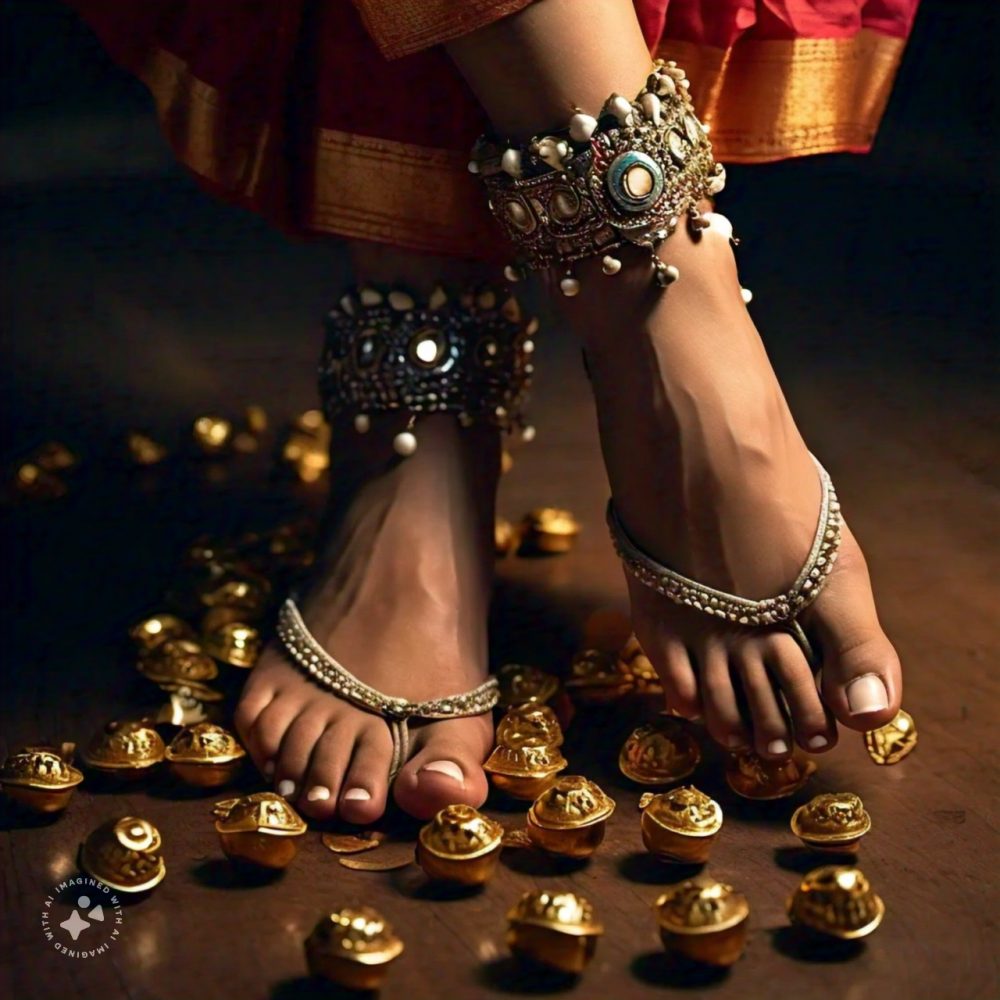
Footnotes of the Divine: The Anklet’s Role in Indian Classical Dance
Recommended for Middle Grades
The Resonant Anklet
In the world of Indian classical dance, where every gesture is a language and every movement a poem, the anklet emerges as a captivating protagonist. Known as salangai or ghungroo, this seemingly simple adornment is far more than meets the eye.
Its rhythmic chimes tell tales of devotion, seduction, and power, echoing through history and resonating with the very soul of India’s rich artistic heritage.
In this exploration, we will delve into the many facets of the anklet, tracing its journey from ancient sculptures to royal courts and unraveling its intricate connection to music, movement, and spirituality.
Anklet’s Echoes in Stone and Verse: A Journey Through Time
The anklet’s story is one that is deeply intertwined with the history and culture of India. It emerges from the mists of time, its earliest representations found in ancient Buddhist terracottas and sculptures, such as the famous Mauryan Didarganj Yakshi.
This 3rd century BC statue, adorned with thick, tire-like anklets, offers a glimpse into the evolution of this ornament, a transformation from simple adornment to a symbol of status and artistry.
As centuries passed, the anklet found its way into the opulent courts of kings and emperors, where it became an emblem of feminine grace and allure. Favored courtesans, adorned with elaborate anklets of gold and precious gems, captivated audiences with their rhythmic footwork and the mesmerizing chime of their ghungroo.
This delicate ornament, once a symbol of fertility and protection, now resonated with the power of seduction and the allure of the forbidden.
But the anklet’s journey didn’t stop at the palace gates. It transcended social boundaries, finding its way into the hearts of common folk and the sacred spaces of temples.
In the devadasi tradition, young dancers were initiated into the art of Indian classical dance through the gajjela puja or salangai puja, a ritual that marked their dedication to the divine and their readiness to perform in the temple’s hallowed halls.
For a deeper understanding of the devadasi tradition and its role in Indian classical dance, visit the website of the Sangeet Natak Akademi.
A Symphony of Sounds: The Anklet’s Musical Language
The true magic of the anklet lies in its ability to transform movement into music, each step a note, each gesture a melody. Every variety of anklet, from the delicate salangai to the heavier silambu, possesses a unique sonic signature, a distinct voice that adds another layer to the dancer’s performance.
Imagine a Bharatanatyam dancer, her ankles adorned with salangai, executing intricate footwork with precision and grace. With each beat, the bells create a mesmerizing symphony of sound, a rhythmic counterpoint to the melody of the mridangam and the haunting strains of the veena.
The tempo increases, the bells crescendo, and the dancer’s movements become a whirlwind of energy and passion, her body a vessel for the divine.
In Kathak, the anklet takes on a different character, its sound becoming a playful tease, a flirtatious invitation to join the dance. The dancer, adorned with rows of ghungroo, spins and twirls, her feet creating intricate patterns on the floor, each step punctuated by the rhythmic jingle of the bells.
The sound is both a metronome and a muse, guiding the dancer’s movements and inspiring her creative expression.
Anklet’s Echoes: A Timeless Tradition
The anklet, a seemingly simple ornament, has woven itself into the very fabric of Indian classical dance. Its rhythmic chimes are the heartbeat of the performance, the pulse that connects the dancer to the music, the audience, and the divine.
In the world of Indian classical dance, the anklet is more than just an accessory; it’s a symbol of India’s rich artistic heritage, a reminder of the intricate connection between music, movement, and spirituality.
Related Stories
- Kathakali in the Digital Age: A Dance with Shadows and Algorithms
- Bharatanatyam Dance Meets Muscle Power
Watch a video
Footsteps of Grace: A Guide to Wearing Ghungroos for Classical Dance!
Curious Times is a leading newspaper and website for kids. We publish daily global news aligned to your learning levels (also as per NEP 2020): Foundational, Preparatory (Primary), Middle and Senior. So, check out the News tab for this. We bring kids’ favourite Curious Times Weekly newspaper every weekend with top news, feature stories and kids’ contributions. Also, check out daily JokesPoke, Tongue Twisters, Word of the Day and Quote of the Day, kids need it all the time.
Curious Times News Program for Schools for FREE. Over 5,000 schools and teachers from all over the world have joined our programme so that students and teachers can get FREE Educative Newspaper. Here, kids can take part in world events and win prizes and certificates for free through their schools.
Moreover, schools are sharing important School News, like interviews with the principal, notices about new students, contests, and results, not just on social media but also on a news website for kids and other schools.
Thus, do not wait any further, sign-up for your school for FREE.
The following social media platforms allow you to communicate with us: WhatsApp, Instagram, Facebook, Youtube, Twitter, and LinkedIn.
0 (Please login to give a Curious Clap to your friend.)
